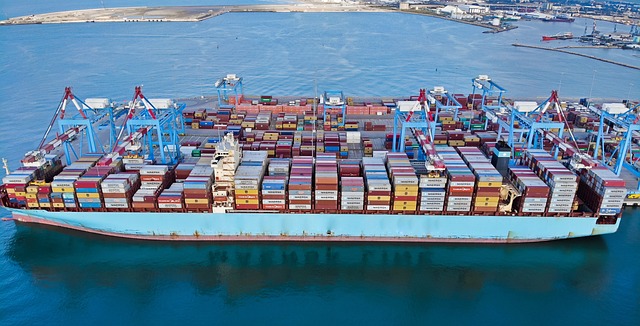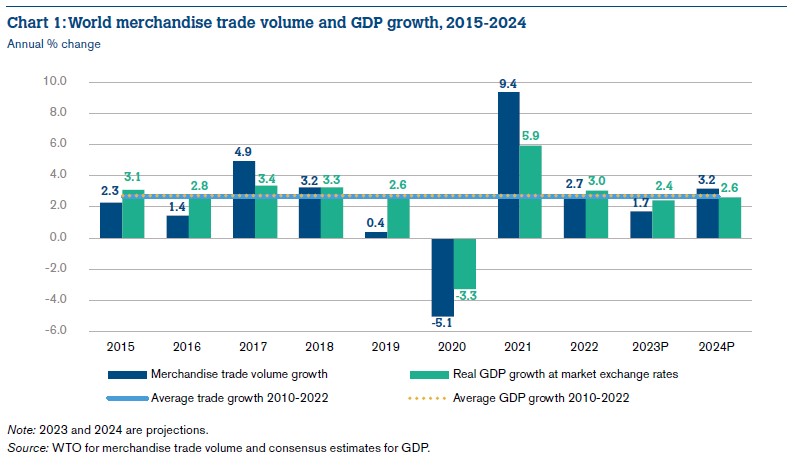April 13, 2023
Global trade growth in 2023 is still expected to be subpar despite a slight upgrade to GDP projections since last fall, WTO economists said in a new forecast on 5 April. Weighed down by the effects of the war in Ukraine, stubbornly high inflation, tighter monetary policy and financial market uncertainty, the volume of world merchandise trade is expected to grow by 1.7% this year, following 2.7% growth in 2022, a smaller-than-expected increase that was pulled down by a sharp slump in the fourth quarter.
The WTO’s trade projections, set out in the new “Global Trade Outlook and Statistics” report, estimate real global GDP growth at market exchange rates of 2.4% for 2023. Projections for both trade and output growth are below the averages for the past 12 years of 2.6% and 2.7% respectively (see chart).
WTO Director-General Ngozi Okonjo-Iweala said: “Trade continues to be a force for resilience in the global economy, but it will remain under pressure from external factors in 2023.This makes it even more important for governments to avoid trade fragmentation and refrain from introducing obstacles to trade. Investing in multilateral cooperation on trade, as WTO members did at our Twelfth Ministerial Conference last June, would bolster economic growth and people’s living standards over the long term.”
The 2.7% increase in world trade volume in 2022 was weaker than the WTO’s October forecast of 3.5%, as a sharper-than-expected quarter-on-quarter decline in the fourth quarter dragged down growth for the year. Several factors contributed to that slump, including elevated global commodity prices, monetary policy tightening in response to inflation, and outbreaks of COVID‑19 that disrupted production and trade in China.
Notably, trade growth last year turned out to be in line with the 2.4% to 3.0% baseline scenario in the WTO’s March 2022 initial report on the war in Ukraine, and well above its more pessimistic scenario in which trade would have grown just 0.5% as countries started to split into competing economic blocs. In the event, international markets remained broadly open. A follow-up study the WTO released last month documented how vulnerable economies were able to compensate for essential food supplies cut off by the war by finding alternative products and suppliers.
The 1.7% forecast for trade growth in 2023, meanwhile, is up from the previous estimate of 1.0% from last October. A key factor here is the relaxation of COVID-19 pandemic controls in China, which is expected to unleash pent-up consumer demand in the country, in turn boosting international trade (see table).
WTO Chief Economist Ralph Ossa said: “The lingering effects of COVID-19 and the rising geopolitical tensions were the main factors impacting trade and output in 2022 and this is likely to be the case in 2023 as well. Interest rate hikes in advanced economies have also revealed weaknesses in banking systems that could lead to wider financial instability if left unchecked. Governments and regulators need to be alert to these and other financial risks in the coming months.”
Looking ahead to 2024, trade growth should rebound to 3.2%, as GDP picks up to 2.6%, but this estimate is more uncertain than usual due to the presence of substantial downside risks, including geopolitical tensions, food supply shocks, and the possibility of unforeseen fallout from monetary tightening.
Source: World Trade Organization
Legal Notice: The information in this article is intended for information purposes only. It is not intended for professional information purposes specific to a person or an institution. Every institution has different requirements because of its own circumstances even though they bear a resemblance to each other. Consequently, it is your interest to consult on an expert before taking a decision based on information stated in this article and putting into practice. Neither Karen Audit nor related person or institutions are not responsible for any damages or losses that might occur in consequence of the use of the information in this article by private or formal, real or legal person and institutions.







